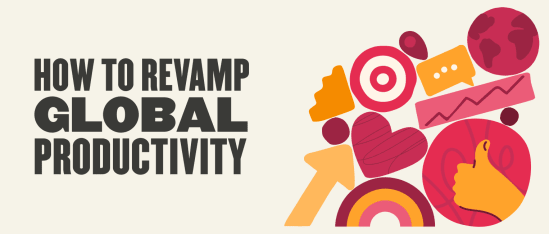Burnout, frustration, and changing priorities at work are having a major impact on businesses all around the world. Namely, they’re affecting employee efficiency and making people less productive.
These dips in motivation and engagement aren’t local phenomena but are truly global. According to Klaas de Vries, an economist at The Conference Board, employee performance worldwide—defined as GDP per hour worked—stagnated in 2021. De Vries forecasted it to stall again in 2022.
In the United States, people are becoming less productive than last year. In fact, productivity is down 4.1 percent YoY, “the biggest decline since the government started keeping track of the number back in 1948.” That’s a significant downturn in output. Productivity is “the fuel that makes it possible for a country’s economy to grow faster than its workforce, thereby increasing per capita GDP growth,” Any drop at your company can significantly impact people’s livelihoods and your future success.
So, what’s the cause? For many, it’s a simple case of burnout or frustration, but the continued effects of the pandemic and the war in Ukraine must also be factored in, contributing to the slow growth in goods consumption.
Luckily, you can do plenty to revamp productivity, encourage your people, and get your business back up to speed. Here are five of our top tips for how to improve productivity in the workplace.
1) Pay attention to your people
People drive workplace productivity. Looking to them should be your first stop when trying to boost productivity.
Burnout usually fuels poor productivity, so identifying and addressing early signs can help you to catch a potential problem before it develops. Speak with your teams regularly through structured HR processes to better understand what could be demotivating them. Consider scheduling anonymous pulse surveys at least once a quarter, build feedback into your performance reviews, and track down any issues that could be puncturing motivation.
For example, do your people need different workplace setups, flexibility, or processes to help them feel engaged and driven to work more effectively? Use the information you gather to build programs focused on sparking excitement, engagement, and enthusiasm—and you’ll see their productivity go up, too.
2) Say goodbye to unproductive meetings
Too many businesses still revolve around an excess of unnecessary, unproductive meetings. Not only do these directly slow your business down, but they also impact people’s enthusiasm for work. This, in turn, damages their productivity even further.
Whether the meeting is in person or over video conference, if you can take care of it in an email or instant message, you should. Needless meetings are a key contributor to burnout and increased employee turnover, so work with your management teams to identify where you can cut back your current expectations.
It’s also a good idea to consider using that time to promote team collaboration and bonding instead. This type of interaction can help improve engagement and individuals’ ability to achieve collective goals.
3) Encourage breaks
It might sound counterintuitive, but championing breaks and time off for your people can significantly impact their productivity. Nothing prevents burnout like time away, and a healthy work-life balance is a key contributor to building an efficient operation.
The key is to lead from the front: Encourage managers to take plenty of time off themselves—both as odd days here and there and longer breaks—and it will set the tone for everyone else. And if individuals on your teams repeatedly fail to take paid time off, make sure you engage them in a conversation to break down any stigma and support them in achieving a healthier balance.
4) Help people set personal goals
People work harder—and better—when they see an important place for themselves in the business, feel engaged, and see tangible benefits for their personal growth and potential career development. Do they have skills that are currently underutilized? Would they be happier or more productive in a different department or regional office? Are they ready to make a step up?
By working with your professionals to set and achieve individual goals, they’ll know you care about investing in their personal growth. It’s also likely they’ll feel more motivated at work because of it. At the same time, sufficient learning and development opportunities are a top priority for today’s professionals, so improving your offer will only strengthen your recruitment and retention efforts.
Recommended For Further Reading
5) Embed trust and flexibility in your company culture
In our own research, we found that an incredible 30 percent of professionals leaving their jobs were doing so to find greater flexibility. It’s clearly at the forefront of many peoples’ minds.
Now, it isn’t always possible to offer completely flexible schedules to every (or any) person in your organization, but there are still plenty of ways you can build their trust in you. Demonstrate that you understand they live complex and fulfilling lives outside work and make regular, open communication a mainstay of your company culture and workflows. More engaged people will reward you with greater motivation and productivity.
Communicate and celebrate
Changes in global productivity are a part of our world, and the shock of recent years has unsurprisingly changed many professionals’ approaches to their work-life balance. By engaging with and listening to them as regularly and openly as possible, you can build HR processes that support a happier, healthier work environment and help increase your people’s productivity, too.


